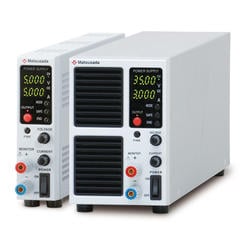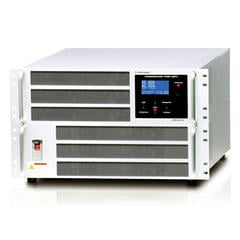Mechanism of Discharge
Discharge takes electricity from the battery. Electrochemical reactions occur in primary or rechargeable batteries, and electrons to be emitted by these reactions. We will explain how electricity is generated by the electrochemical reaction in the battery.
There are positive and negative electrodes in the battery. The negative electrode emits electrons by the oxidation reaction caused by bonding with oxygen. On the other hand, a reduction reaction occurs by absorbing electrons at the positive electrode. In other words, the surplus electrons generated at the negative electrode move to compensate for the missing electrons by the reduction reaction that occurs at the positive electrode.
The redox reaction occurring at each electrode differs depending on the material of the electrode and the electrolyte solution. These chemical reactions continue until there is no substance necessary for the reaction. In other words, the battery can keep generating electricity until fully discharged.
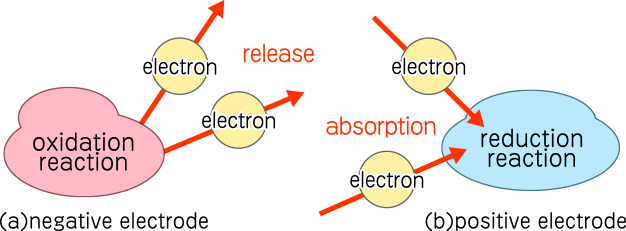
Mechanism of Charge
On the other hand, charging is sending electricity to storage batteries for reuse. In a fully discharged battery, substances in the battery maintain chemical equilibrium without any electrochemical reaction. However, it is possible to return to the state before discharge by causing a chemical reaction that extracts electricity from the positive electrode and gives electrons to the negative electrode.
An oxidation reaction occurs at the positive electrode and a reduction reaction occurs at the negative electrode by discharge. The electrons sent from the external power supply cause a reverse electrochemical reaction in the rechargeable battery. On the other hand, primary batteries cannot be charged. Because the chemical reaction is irreversible or the cost is high for charging even if it is a reversible reaction, it is disposable.

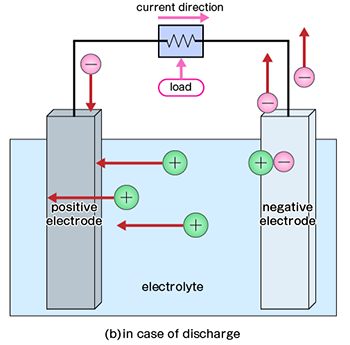
Chemical Reaction and Electrical Characteristics during Charge and Discharge
Now, we introduce examples of chemical reactions during charge/discharge and electrical characteristics of various batteries in terms of "electrochemistry".
First, we explain the chemical reaction inside the storage battery, taking NiMH (nickel-metal hydride battery) as an example. A nickel acid compound is used for the positive electrode, and a hydrogen storage alloy is used for the negative electrode in NiMH. During charging, water molecules are generated from hydroxide ions at the positive electrode. Water molecules are decomposed into hydrogen atoms and hydroxide ions at the negative electrode, and hydrogen atoms are stored in a hydrogen storage alloy. The chemical reaction formula is as follows (M means hydrogen storage alloy).

During discharging, hydroxide ions are generated from water molecules at the positive electrode, and they move from the positive electrode to the negative electrode in the electrolyte. Hydroxide ions transferred to the negative electrode receive hydrogen ions from the hydrogen storage alloy and return to water molecules. The chemical reaction formula is as follows.

If this reaction is written in the electrochemical equilibrium formula, it becomes as follows.

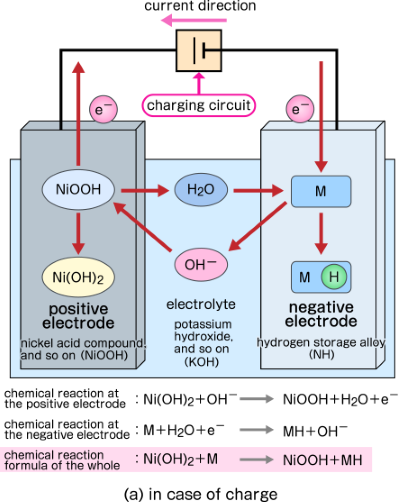
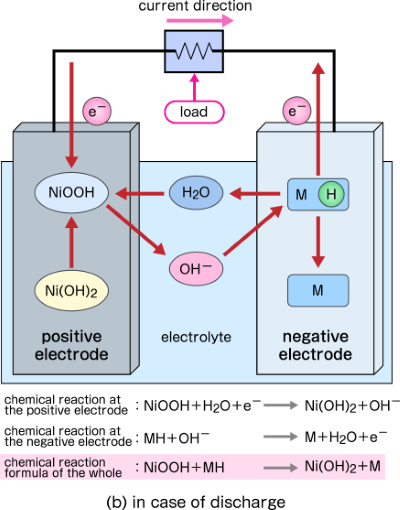
This second line is described the standard electrode potential E0 by the electrochemical reaction. The electric characteristics of the battery can be described by the standard electrode potential which can theoretically give out the potential.
Electricity is generated through a chemical reaction in the battery. And Electricity supplied amount depends on the type of battery. Just as atoms and molecules have individuality, the energy of generated electrons also differs by the electrochemical reaction.
The theoretical electromotive force is defined by the difference of electrical potential generated by the combination of the positive and negative electrode materials. This is the standard electrode potential. Then the energy of electrons generated at each pole is defined by the potential measured from SHE (Standard Hydrogen Electrode). "vs. SHE" means "SHE standard".
For example, in the case of a lithium-ion storage battery, if you use lithium cobaltite (LiCoO2) for the positive electrode and carbon for the negative electrode to extract electrons from Li, the difference of electrical potential with SHE is +0.87 V for the positive electrode and -2.83 for the negative electrode. The standard electrode potential is 0.87 - (-2.83) = 3.7 V vs. SHE.
Similarly, 1.32 V vs. SHE for NiCd (nickel-cadmium) batteries and 1.55 V vs. SHE for NiMH batteries. However, the EMF of the NiCd battery and NiMH battery is about 1.2 V, which is a little lower than the theoretical values.
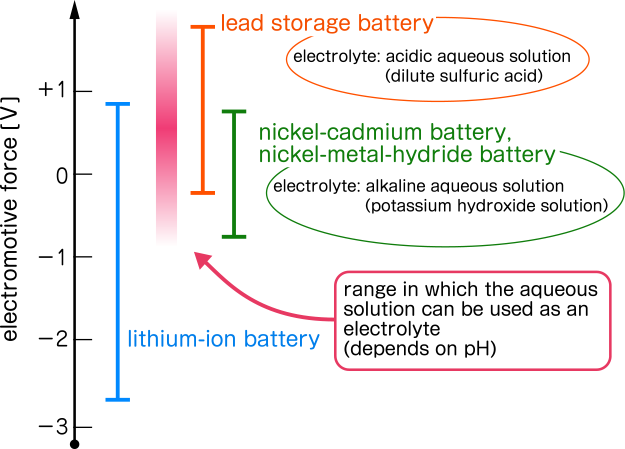
In the case of lead-acid batteries that are often used in automotive batteries, lead dioxide (PbO2) is used for the positive electrode and lead (Pb) for the negative electrode. Then the standard electrode potential of the positive electrode SHE standard is 1.70, and the negative electrode is -0.35, it will be about 2.0 V vs. SHE. This value almost agrees with the nominal value of the electromotive force of the lead-acid battery.
The standard electrode potentials of each battery are summarized in Table 1.

Well, what should we improve the electromotive force? For lithium-ion batteries, the potential at which Li emits electrons is approximately -3.0 V vs. SHE, so it has almost reached the theoretical limit. Therefore, there is no choice but to raise the potential on the positive side. As another choice, we treat one battery as a unit called a "cell." The voltage can be increased by connecting several cells in series. For example, in the case of a lead-acid battery, one cell is 2 V, so six cells are connected in series in the case of an automotive 12 V battery. The same way is done with a notebook computer. For example, the EMF is realized by connecting three lithium-ion batteries in series in the case of a 10.8 V drive.
Finally, I will explain the memory effect. The memory effect causes the battery voltage drops in the case of NiCd and NiMH batteries, if the battery is recharged before fully discharging. It is called a memory effect because it relies on the effects of the previous discharge situation. If charging before fully discharging, the voltage required for operation cannot be obtained in the case of equipment requiring high voltage such as a digital camera. This is known to recover from fully discharging, but we're not sure why memory effects exist.

On the other hand, lithium-ion batteries have no memory effect and are suitable for repeated use. However, for both positive and negative electrodes, an intercalation reaction occurs in which Li+ enters and leaves the gap of the electrode structure material. This causes the electrode material to expand and contract slightly due to charge and discharge. But it is more stable than other batteries.
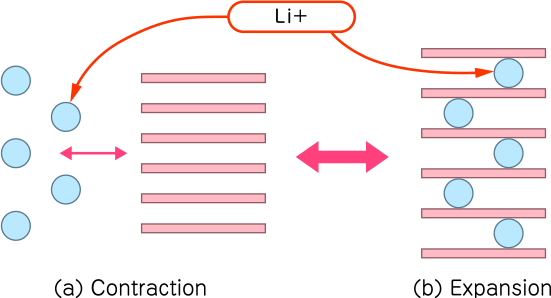
The structure of the battery is rarely broken by the intercalation reaction. However, the material used is broken and expanded due to deposited metallic lithium, because overcharging or overdischarging is repeated. This causes the battery pack of a smartphone that uses a lithium-ion battery to expand and sometimes ignite or explode.
Related Technical Articles
Recommended products
Matsusada Precision's battery cycle testers, DC power supplies, and bidirectional power supplies (regenerative power supplies) are used in evaluation tests and production lines for electric batteries such as lithium-ion batteries and capacitors.
Reference (Japanese site)
- Japanese source page 「充電・放電時に二次電池内部では何が起こっているか?」
(https://www.matsusada.co.jp/column/secondary-battery.html) - 「充電用電池の基礎と電源回路設計」トランジスタ技術SPECIAL2013 Winter, No.121
(https://shop.cqpub.co.jp/detail/1402/) - 電気化学便覧 第6版
(https://www.maruzen-publishing.co.jp/item/b294140.html) - 電子移動の化学 -電気化学入門
(https://www.asakura.co.jp/detail.php?book_code=14593)



